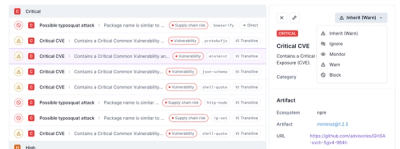
Research
Security News
Malicious npm Package Typosquats react-login-page to Deploy Keylogger
Socket researchers unpack a typosquatting package with malicious code that logs keystrokes and exfiltrates sensitive data to a remote server.
@angular/router
Advanced tools
Package description
The @angular/router package provides navigation and URL manipulation capabilities for Angular applications. It allows developers to define routes, navigate between them, handle route parameters, and guard routes among other functionalities.
Route Configuration
Defines routes in an Angular application, associating paths with components.
const routes: Routes = [
{ path: 'home', component: HomeComponent },
{ path: 'about', component: AboutComponent }
];
@NgModule({
imports: [RouterModule.forRoot(routes)],
exports: [RouterModule]
})
export class AppRoutingModule { }Router Outlet
A placeholder that Angular dynamically fills based on the current router state.
<router-outlet></router-outlet>Navigation
Programmatically navigate to different routes within an Angular application.
constructor(private router: Router) { }
navigateToHome() {
this.router.navigate(['/home']);
}Route Parameters
Access parameters for a given route, often used for fetching data based on the URL.
constructor(private route: ActivatedRoute) { }
ngOnInit() {
this.route.paramMap.subscribe(params => {
this.userId = params.get('id');
});
}Route Guards
Protect routes with guards that can allow or prevent navigation to a route based on logic such as authentication.
@Injectable({ providedIn: 'root' })
export class AuthGuard implements CanActivate {
canActivate(
next: ActivatedRouteSnapshot,
state: RouterStateSnapshot): Observable<boolean> | Promise<boolean> | boolean {
return this.authService.isAuthenticated();
}
}React Router is a routing library for React, similar to @angular/router but for React applications. It provides components for navigation, route matching, and history handling. While @angular/router is designed specifically for Angular, React Router is tailored to React's component structure.
Vue Router is the official router for Vue.js. It integrates deeply with Vue.js core to make building Single Page Applications with Vue.js a breeze. It offers features similar to @angular/router but is designed to work seamlessly with Vue.js components and reactivity system.
Next.js router is a minimalistic routing solution for Next.js applications. It provides navigation and server-side rendering support for React applications built with Next.js. It differs from @angular/router in that it is optimized for static site generation and server-rendered applications.
Reach Router is a small, simple router for React that is accessible and easy to use. It is similar to @angular/router in providing navigation and route matching, but it focuses on simplicity and accessibility. It has now been succeeded by React Router, which has incorporated its accessibility features.
Readme
Managing state transitions is one of the hardest parts of building applications. This is especially true on the web, where you also need to ensure that the state is reflected in the URL. In addition, we often want to split applications into multiple bundles and load them on demand. Doing this transparently isn’t trivial.
The Angular router is designed to solve these problems. Using the router, you can declaratively specify application state, manage state transitions while taking care of the URL, and load components on demand. In this article I will discuss the API of the router, as well as the mental model and the design principles behind it.
Read the in-depth overview of the Router here.
FAQs
Unknown package
We found that @angular/router demonstrated a healthy version release cadence and project activity because the last version was released less than a year ago. It has 2 open source maintainers collaborating on the project.
Did you know?

Socket for GitHub automatically highlights issues in each pull request and monitors the health of all your open source dependencies. Discover the contents of your packages and block harmful activity before you install or update your dependencies.

Research
Security News
Socket researchers unpack a typosquatting package with malicious code that logs keystrokes and exfiltrates sensitive data to a remote server.

Security News
The JavaScript community has launched the e18e initiative to improve ecosystem performance by cleaning up dependency trees, speeding up critical parts of the ecosystem, and documenting lighter alternatives to established tools.

Product
Socket now supports four distinct alert actions instead of the previous two, and alert triaging allows users to override the actions taken for all individual alerts.